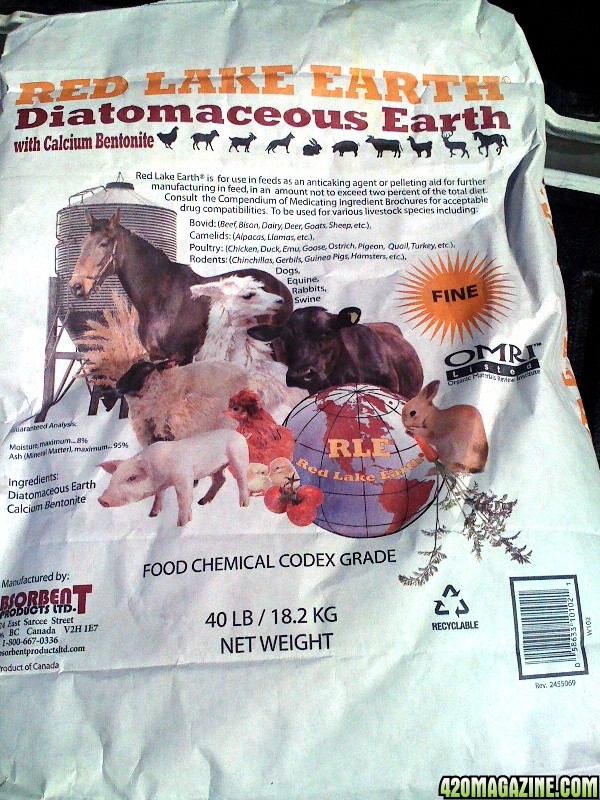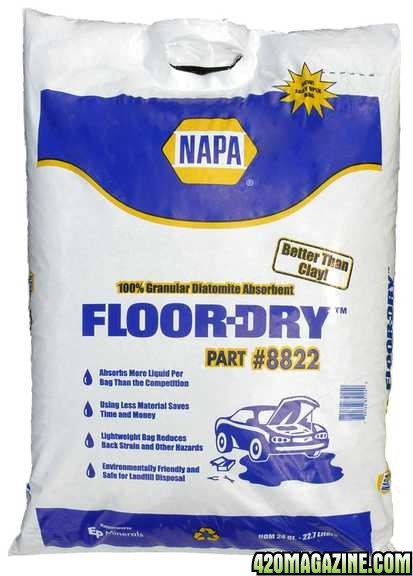SmokzAlot
New Member
Diatomaceous Earth
From Wikipedia, the free encyclopedia
Diatomaceous earth also known as diatomite or kieselgur/kieselguhr, is a naturally occurring, soft, siliceous sedimentary rock that is easily crumbled into a fine white to off-white powder. It has a particle size ranging from less than 1 micrometre to more than 1 millimetre, but typically 10 to 200 micrometres. This powder has an abrasive feel, similar to pumice powder, and is very light as a result of its high porosity. The typical chemical composition of oven-dried diatomaceous earth is 80 to 90% silica, with 2 to 4% alumina (attributed mostly to clay minerals) and 0.5 to 2% iron oxide.[1]
Diatomaceous earth consists of fossilized remains of diatoms, a type of hard-shelled algae. It is used as a filtration aid, mild abrasive, mechanical insecticide,[2] absorbent for liquids, matting agent for coatings, reinforcing filler in plastics and rubber, anti-block in plastic films, porous support for chemical catalysts, cat litter, activator in blood clotting studies, and a stabilizing component of dynamite. As it is heat-resistant, it can also be used as a thermal insulator.
Use in Agriculture
Natural freshwater diatomaceous earth is used in agriculture for grain storage as an anticaking agent, as well as an insecticide.[16] It is approved by the US Department of Agriculture as a feed supplement.
It is also used as a neutral anthelmintic (dewormer). Some farmers add it to their livestock and poultry feed to improve the health of animals.[17] "Food Grade Diatomaceous Earth" is widely available in agricultural feed supply stores. It is acceptable as organic feed additive for livestock.
Use in Hydroponics
Freshwater diatomite can be used as a growing medium in hydroponic gardens. It is also used as a growing medium in potted plants, particularly as bonsai soil. Bonsai enthusiasts use it as a soil additive, or pot a bonsai tree in 100% diatomaceous earth. Like perlite, vermiculite, and expanded clay, it retains water and nutrients, while draining fast and freely, allowing high oxygen circulation within the growing medium.
Use in Pest Control
Diatomite is used as an insecticide, due to its physico-sorptive properties. The fine powder absorbs lipids from the waxy outer layer of insects' exoskeletons, causing them to dehydrate.[9] Arthropods die as a result of the water pressure deficiency, based on Fick's law of diffusion. This also works against gastropods and is commonly employed in gardening to defeat slugs.
So what does this mean to me? How can I use it in my garden?
It may be the best all natural pest killer and prevent there is, and it's all natural.
You can apply directly to the soil as an amendment or top dressing. You can dust your plants with it as well with a common garden duster. Can be also applied as a foliar feed but will not be effective till it dries. Hence the duster is a better choice. If any pests cross it or ingest it, they are doomed. These jagged edges pierce the waxy protective layer of the exoskeleton, opening the bodily fluids to the dessication effects of the silica. This, obviously, is a very bad thing for the bugs. The bodily fluids are rapidly depleted by the silica, leaving one very dead bug.
As Diatomaceous earth is also comprised of 70-80% silica it is also beneficial for our garden, which is good for the plant both in root health and the support structures, making it more resistant to attacks. Silica GOOD
So practically anything you can think of it can be applied to. Sprinkle it around the grow room. At entry points and cracks where pest enter or harbor. Apply to grow medium the drip tray, anywhere they may cross.
Are we done? Not quite it also is a beneficial amendment to loosen soils and provide more moisture retention much like vermiculite. Or as stated you can just grow in it, being it is an inert medium like perlite and vermiculite.
Where do I get it?
First off don't use Swimming Pool DE is has been treated and is not the same. It is normally easy to locate at any feed and grain supply as it is a regular staple in the agriculture community. Powder is what you want as a first choice as it more applicable to a multitude of applications. The course stuff they sell at the hydro shop is more adept for a growing medium. Health food stores and the like will carry FDA approved food grade that is safe for consumption as well.
Now on to alternative sources....
Napa Auto Parts sells a floor dry product that is 100% DE
Non clumping cat litters are also made with DE, some 100%
From Wikipedia, the free encyclopedia
Diatomaceous earth also known as diatomite or kieselgur/kieselguhr, is a naturally occurring, soft, siliceous sedimentary rock that is easily crumbled into a fine white to off-white powder. It has a particle size ranging from less than 1 micrometre to more than 1 millimetre, but typically 10 to 200 micrometres. This powder has an abrasive feel, similar to pumice powder, and is very light as a result of its high porosity. The typical chemical composition of oven-dried diatomaceous earth is 80 to 90% silica, with 2 to 4% alumina (attributed mostly to clay minerals) and 0.5 to 2% iron oxide.[1]
Diatomaceous earth consists of fossilized remains of diatoms, a type of hard-shelled algae. It is used as a filtration aid, mild abrasive, mechanical insecticide,[2] absorbent for liquids, matting agent for coatings, reinforcing filler in plastics and rubber, anti-block in plastic films, porous support for chemical catalysts, cat litter, activator in blood clotting studies, and a stabilizing component of dynamite. As it is heat-resistant, it can also be used as a thermal insulator.
Use in Agriculture
Natural freshwater diatomaceous earth is used in agriculture for grain storage as an anticaking agent, as well as an insecticide.[16] It is approved by the US Department of Agriculture as a feed supplement.
It is also used as a neutral anthelmintic (dewormer). Some farmers add it to their livestock and poultry feed to improve the health of animals.[17] "Food Grade Diatomaceous Earth" is widely available in agricultural feed supply stores. It is acceptable as organic feed additive for livestock.
Use in Hydroponics
Freshwater diatomite can be used as a growing medium in hydroponic gardens. It is also used as a growing medium in potted plants, particularly as bonsai soil. Bonsai enthusiasts use it as a soil additive, or pot a bonsai tree in 100% diatomaceous earth. Like perlite, vermiculite, and expanded clay, it retains water and nutrients, while draining fast and freely, allowing high oxygen circulation within the growing medium.
Use in Pest Control
Diatomite is used as an insecticide, due to its physico-sorptive properties. The fine powder absorbs lipids from the waxy outer layer of insects' exoskeletons, causing them to dehydrate.[9] Arthropods die as a result of the water pressure deficiency, based on Fick's law of diffusion. This also works against gastropods and is commonly employed in gardening to defeat slugs.
So what does this mean to me? How can I use it in my garden?
It may be the best all natural pest killer and prevent there is, and it's all natural.
You can apply directly to the soil as an amendment or top dressing. You can dust your plants with it as well with a common garden duster. Can be also applied as a foliar feed but will not be effective till it dries. Hence the duster is a better choice. If any pests cross it or ingest it, they are doomed. These jagged edges pierce the waxy protective layer of the exoskeleton, opening the bodily fluids to the dessication effects of the silica. This, obviously, is a very bad thing for the bugs. The bodily fluids are rapidly depleted by the silica, leaving one very dead bug.
As Diatomaceous earth is also comprised of 70-80% silica it is also beneficial for our garden, which is good for the plant both in root health and the support structures, making it more resistant to attacks. Silica GOOD
So practically anything you can think of it can be applied to. Sprinkle it around the grow room. At entry points and cracks where pest enter or harbor. Apply to grow medium the drip tray, anywhere they may cross.
Are we done? Not quite it also is a beneficial amendment to loosen soils and provide more moisture retention much like vermiculite. Or as stated you can just grow in it, being it is an inert medium like perlite and vermiculite.
Where do I get it?
First off don't use Swimming Pool DE is has been treated and is not the same. It is normally easy to locate at any feed and grain supply as it is a regular staple in the agriculture community. Powder is what you want as a first choice as it more applicable to a multitude of applications. The course stuff they sell at the hydro shop is more adept for a growing medium. Health food stores and the like will carry FDA approved food grade that is safe for consumption as well.
Now on to alternative sources....
Napa Auto Parts sells a floor dry product that is 100% DE
Non clumping cat litters are also made with DE, some 100%









